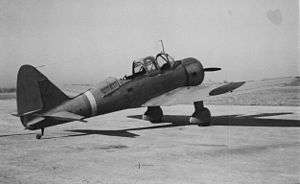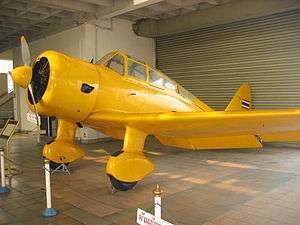Tachikawa Ki-36
| Ki-36 | |
|---|---|
 | |
| Role | Two-seat Army Co-operation Aircraft |
| Manufacturer | Tachikawa Aircraft Company Ltd |
| First flight | 20 April 1938 |
| Primary users | Imperial Japanese Army Air Force Royal Thai Air Force |
| Produced | 1938 - 1944 |
| Number built | 1,334 |
| Variants | Tachikawa Ki-55 |
The Tachikawa Ki-36 (named Ida in Allied reporting code) was a Japanese army co-operation aircraft of World War II. It was a two-seat, low-wing monoplane with a single piston engine and fixed, tailwheel-type undercarriage.
Design and development
The prototype, fitted with a 450 hp (336 kW) Hitachi Army Type 98 Ha-13 engine, first flew on 20 April 1938. Having outperformed the Mitsubishi Ki-35 in comparative trials, the Ki-36 was designated the Army Type 98 Direct Co-operation Aircraft and ordered into production in November 1938. Production ended in January 1944 after a total of 1,334 Ki-36 had been built (Tachikawa 862 and Kawasaki 472).[1]
Operational history
The Ki-36 first saw action in China where it saw success. Later, in the Pacific, it proved excessively vulnerable to opposing fighters. It was thereafter redeployed to the safer theater of China. Towards the end of the war, the Ki-36 was employed as a kamikaze aircraft with a bomb of 500-kg (1,102-lb) fitted externally.[2]
Variants
- Ki-55 : Two-seat advanced trainer version.
- Ki-72 : An evolved version with a 600-hp (447-kW) Hitachi Ha-38 engine and retractable undercarriage. Not built.
Operators

- Chinese Communist Air Force operated two captured aircraft postwar as trainers until their retirement in early 1950s.
Specifications (Ki-36)
Data from Japanese Aircraft of the Pacific War;[2] The Concise Guide to Axis Aircraft of World War II[3]
General characteristics
- Crew: two
- Length: 8.00m (25ft 3in)
- Wingspan: 11.80m (38ft 8.5in)
- Height: 3.64m (11ft 11.25in)
- Wing area: 20m² (215.29ft²)
- Empty weight: 1,247kg (2,749lb)
- Loaded weight: 1,660kg (3,660lb)
- Powerplant: 1 × Hitachi Army Type 98 Ha-13a nine cylinder air-cooled radial engine, 380kW (510hp)
Performance
- Maximum speed: 348km/h (216mph)
- Cruise speed: 235km/h (146mph)
- Range: 1,235km (767mi)
- Service ceiling: 8,150m (26,740ft)
- Wing loading: 83kg/m² (17lb/ft²)
- Power/mass: 0.23kW/kg (0.31hp/kg; 0.14hp/lb)
- Time to 3000m (9,845ft): 6min 39sec
Armament
- one fixed, forward-firing 7.7mm (0.303in) machine-gun , one flexible 7.7mm (0.303in) machine-gun in rear cockpit.
- up to 150kg (331lb) external bombload.
See also
- Related development
- Related lists
References
Citations
- ↑ Francillon 1979, p. 254.
- 1 2 Francillon 1979, p. 253.
- ↑ Mondey 1996, p. 246.
Bibliography
- Francillon, Ph.D., René J. Japanese Aircraft of the Pacific War. London: Putnam Aeronautical, 1987. ISBN 0-85177-801-1.
- Mondey, David. The Concise guide to Axis Aircraft of World War II. London: Chancellor Press, 1996. ISBN 1-85152-966-7.
External links
| Wikimedia Commons has media related to Tachikawa Ki-36. |